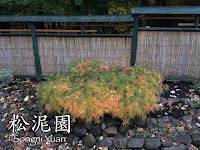The large shrub at the eastern end of the garden was taken down. This shrub, which had become more tree-like, was actually a Burning Bush (Euonymus alatus). It was growing on the neighboring property and was part of what had become a hedge row.
When we first moved into this house over 20 years ago, it was growing up against a garden shed. After the construction of the garage and the moving of the shed, the bush began to grow quickly, especially since it had more direct access to sunlight.
 |
| shrub, seen directly behind me pre-fence |
Eventually, I built the fence, but the shrub continued to grow. At that point, I took control of the shrub and began to trim and shape it so that it conformed to the garden plan. Nine years later I had created a spectacular shrub/tree, one that I came to admire.
Unfortunately, I did too good a job. Although shaped to compliment the fence, the canopy continued to grow. Not only did it grow in height, it also spread far across the fence line. At first it looked great, but more recently the canopy had become so large that it was beginning to produce too much shade over the west end of the garden above Buddha. Plants in the area were begging to show signs that they were not receiving enough sunlight. Even the Hosta were suffering.
 | |
|
Although I had decided earlier this year that the shrub would have to go during the fall, it was the death of my neighbor that necessitated its departure. My neighbor was an elderly gentleman who had come to appreciate my garden and landscaping efforts. During the summer months, I would see him on almost a daily basis. If he saw me out working on the yard or garden he would come out and we would talk at length. When he passed away I was saddened. I had come to look forward to our chats. He was a good friend and neighbor. After his passing, his son gave my permission to remove the shrub/tree. Even so, I had been putting off the removal, not wanting to undo all the hard work and effort I had employed to foster such a beautiful specimen.
This fall, the shrub was looking as good as ever as the color began to change.
Finally, the property going up for sale hastened the necesity to move forward.
Now gone the garden seems different. With fall upon us and the leaves almost gone, its too difficult to see what the impact will be. Only spring will tell. I am hopeful that the remaining hedge row of Euonymus alatus can begin to fill in the void without crowding or over-topping the fence line.
In the end I am sad over the losses of this season. However, I also realize that old friends never die, as long as the living keep them in their hearts and memories.
















































